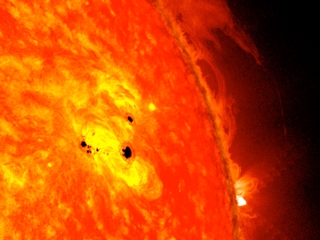Fast-Growing Sunspots

Scientists observe dynamic magnetic regions on the sun the size of planets.
As magnetic fields on the sun rearrange and realign, dark spots known as sunspots can appear on its surface. Since its launch, NASA’s Solar Dynamics Observatory, or SDO, spacecraft has seen many fast-growing sunspots, some of which were quite large. In February 2013, scientists watched a giant sunspot form in under 48 hours that grew to over six times the size of Earth. The spot quickly evolved into what's called a delta region, in which the lighter areas around the sunspot exhibit magnetic fields that point in the opposite direction of those fields in the center. This is a fairly unstable configuration that scientists know can lead to eruptions of radiation on the sun called solar flares. Explore the images to see views of sunspots captured by SDO.

SDO captured this image of sunspots in February 2013. The bottom two clusters appeared over the course of two days and are over six Earths across.

This group of Earth-sized sunspots produced multiple solar flares, including two X-class, the strongest type of flare.

Several major eruptions came from this growing chain of sunspots in 2011.

A gigantic sunspot—almost as big as Jupiter—can be seen on the lower center of the sun in this image taken in 2014.
Credits
Please give credit for this item to:
NASA's Goddard Space Flight Center
Images courtesy of NASA/SDO
-
Writer
- Karen Fox (ADNET Systems, Inc.)
Release date
This page was originally published on Thursday, December 10, 2015.
This page was last updated on Wednesday, May 3, 2023 at 1:49 PM EDT.
